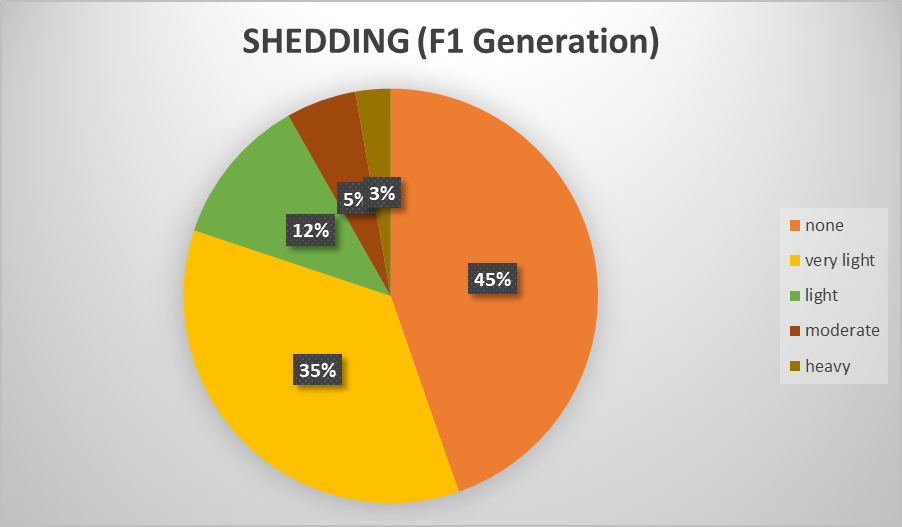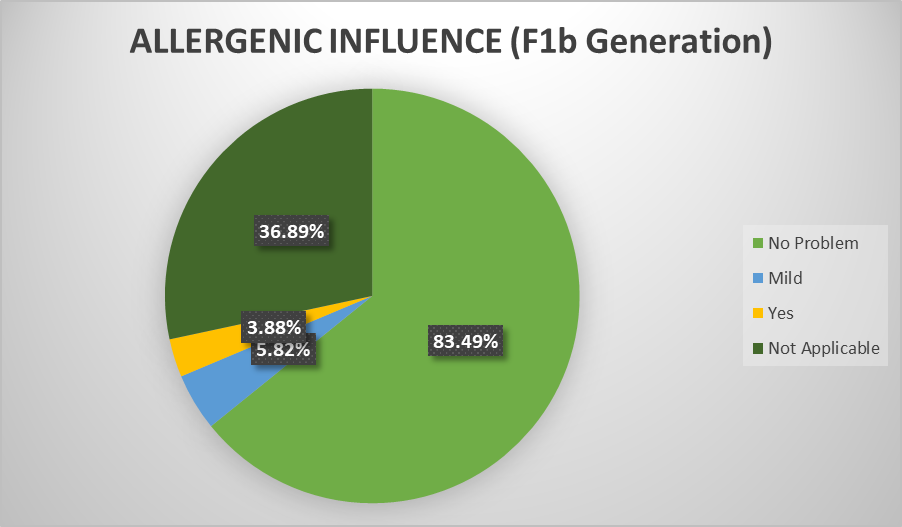"Why does the 'F-Factor' matter? A 'doodle' is a 'doodle' (or is it?)"
There is a common misconception that doodle's don't shed at all; All animals shed, but some less than others. Now that we're on the same page, anyone who wants or needs a near non-shedding doodle should buy an F1b generation. Here’s how to make a doodle
- F1 "typical" a Pure-Bred Poodle (female) with a Pure-Bred non-poodle (male) with a medium-risk of shedding/allergenic influence.
- F1b "crossback"; a pure-bred poodle (female) with a 50/50 doodle results in a 75/25 (75% poodle; 25% non-poodle). Since the poodle coat is the dominant, there is a very low or "hypo" probability of shedding (hence the hypo-allergenic).
- F2 "double-doodle"; an F1 or F1b bred with another F1 or F1b. Double the "Doodle", but not double the benefits. This mixture has significant coat variation (color AND type), so they are not a prefered hybrid as the coats are highly unpredictable (higher risk of shedding/allergenic influence).
a 2018 survey of Goldendoodle owners and found the following stats:
Generation F1 results
Generaton F1b results
The charted data above clearly show there is a significantly lower chance for shedding or allergies in the the F1b doodles (25%-75%) than the typical F1 doodles (50%-50%).
"Doodles aren't hypoallergenic...there is no such thing as a hypoallergenic animal!"
Actually, yes...there is. All too often we (and other breeders) are "called out" for false advertising by stating our doodles are hypoallergenic and that we should just state they don't shed like a normal dog, thus would be more allergy-friendly. Apparently some people misunderstand the term "hypoallergenic," which simply means that a particular dog or breed of dogs (in this case poodles/doodles) is less likely to cause allergies. It is fairly common knowledge that the English prefix "hypo" means "less than" or "under." Hypothermia is someone extremely cold due to a less than normal body temperature. Hypothyroidism is an under-active thyroid gland. People with hypoglycemia have low blood sugar. A hypochondriac is less sensible than a normal person about their health (imaginary diseases, etc). A hypothesis is a less than proven thesis; a theory that still needs proof. A hypocrite is less moral than they pass themselves off as. Hypoxia is a person who has less than a normal amount of oxygen reaching their tissue.
If you look up the word "Hypoallergenic", the wiktionary will show Miriam-Webster puts the date at 1940 for its first use and some say it was coined by advertisers in the 1950's. Wikipedia further describes it as meaning "below normal" or "slightly" allergenic. "It is used to describe items (especially cosmetics and textiles) that cause or are claimed to cause fewer allergic reactions. Hypoallergenic pet breeds still produce allergens, but because of their coat type, absence of fur, or absence of a gene that produces a certain protein, they typically produce fewer allergens than other breeds of the same species may. Some species of pets such as the pig are considered hypoallergenic as a whole, regardless of breed. People with severe allergies and asthma may still be affected by a hypoallergenic pet". Later on, there is even a section about "Hypoallergenic Pets" that states, "Hypoallergenic pets are breeds of pet animals (e.g., some breeds of dogs) that are less likely to trigger allergic reactions in people who are sensitized to the pet species (e.g., in people generally allergic to dogs)".
The use of the term "hypoallergenic" by breeders should be used responsibly and honestly. We will ALWAYS inform any prospective customer that no dog is non-allergenic; they should interact with a doodle (ideally, an F1b) to see if their allergies respond negatively.
If you look up the word "Hypoallergenic", the wiktionary will show Miriam-Webster puts the date at 1940 for its first use and some say it was coined by advertisers in the 1950's. Wikipedia further describes it as meaning "below normal" or "slightly" allergenic. "It is used to describe items (especially cosmetics and textiles) that cause or are claimed to cause fewer allergic reactions. Hypoallergenic pet breeds still produce allergens, but because of their coat type, absence of fur, or absence of a gene that produces a certain protein, they typically produce fewer allergens than other breeds of the same species may. Some species of pets such as the pig are considered hypoallergenic as a whole, regardless of breed. People with severe allergies and asthma may still be affected by a hypoallergenic pet". Later on, there is even a section about "Hypoallergenic Pets" that states, "Hypoallergenic pets are breeds of pet animals (e.g., some breeds of dogs) that are less likely to trigger allergic reactions in people who are sensitized to the pet species (e.g., in people generally allergic to dogs)".
The use of the term "hypoallergenic" by breeders should be used responsibly and honestly. We will ALWAYS inform any prospective customer that no dog is non-allergenic; they should interact with a doodle (ideally, an F1b) to see if their allergies respond negatively.
The AKC has a list of several breeds that are less likely to cause allergies.
Medical doctor, Clifford W. Bassett proved that non-shedding dog breeds are much more likely to be hypoallergenic. Essentially people who own a poodle (or poodle-cross) are less likely to develop severe allergies than many other breeds. Read the full article in Asthma Magazine, volume 7, Issue 3, May 2002, Pages 31-32. by Clifford W. Bassett, MD, (a Fellow of the American Academy of Allergy, Asthma and Immunology (AAAAI). He works at NYU Medical Center and has a private practice in New York, New York)
Medical doctor, Clifford W. Bassett proved that non-shedding dog breeds are much more likely to be hypoallergenic. Essentially people who own a poodle (or poodle-cross) are less likely to develop severe allergies than many other breeds. Read the full article in Asthma Magazine, volume 7, Issue 3, May 2002, Pages 31-32. by Clifford W. Bassett, MD, (a Fellow of the American Academy of Allergy, Asthma and Immunology (AAAAI). He works at NYU Medical Center and has a private practice in New York, New York)



